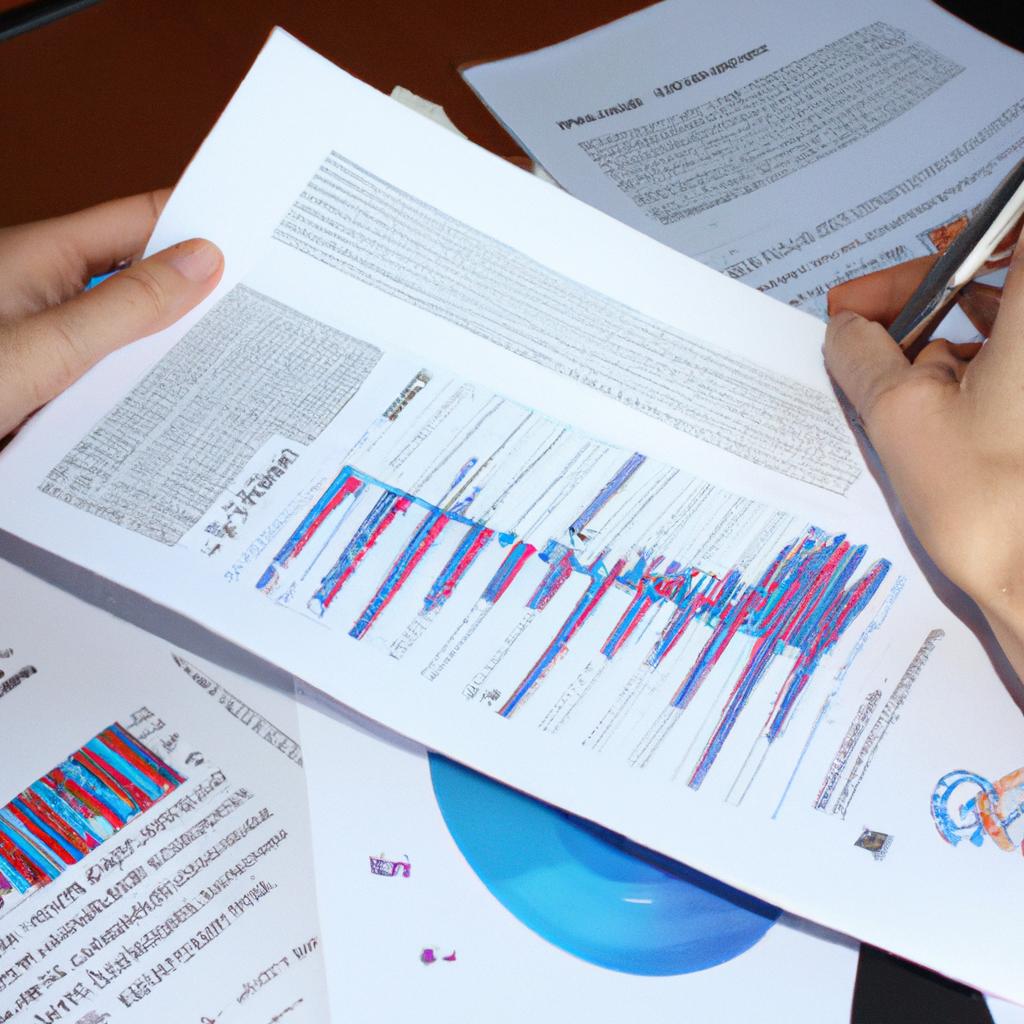Music royalties are a crucial aspect of the financial landscape in the music industry. These royalties serve as a form of compensation for artists and creators, ensuring that they receive fair remuneration for their work. The intricate system of music royalties involves various stakeholders such as songwriters, composers, performing artists, publishers, record labels, and digital platforms. Understanding how these royalties are calculated and distributed is essential for both musicians and individuals interested in the business side of arts music.
To illustrate the significance of music royalties, let us consider the hypothetical case study of an independent singer-songwriter named Alex. With an undeniable talent for crafting heartfelt lyrics and captivating melodies, Alex writes and records original songs. As Alex’s popularity grows on streaming platforms like Spotify or Apple Music, their songs gain traction among listeners worldwide. In this scenario, it becomes vital for Alex to comprehend the complexities of music royalties to ensure a sustainable income stream from their artistic endeavors. This article will explore the different types of music royalties and delve into their financial implications within the realm of arts music.
What are music royalties?
Music royalties refer to the payments that artists receive for the use of their musical compositions or recordings. These royalties play a crucial role in the financial aspect of arts music, ensuring that creators and rights holders are compensated for their work. To further illustrate this concept, let’s consider an example:
Imagine a talented songwriter named Alex who writes and produces a hit song called “Melodies of Life.” This song becomes incredibly popular and is streamed on various platforms like Spotify, Apple Music, and YouTube. As people around the world listen to “Melodies of Life,” Alex is entitled to receive royalties as compensation for his creative efforts.
To delve deeper into the significance of music royalties, let us explore some key points:
- Royalties provide artists with a means to generate income from their artistic creations.
- They serve as recognition and appreciation for the time, effort, and talent invested by musicians.
- Royalties contribute towards sustaining creativity within the industry by enabling artists to continue producing new works.
- The fair distribution of royalties ensures equitable compensation among all parties involved in the creation process.
| Types of Music Royalties | Description |
|---|---|
| Mechanical Royalties | Paid when songs are reproduced onto physical formats such as CDs or digital downloads. |
| Performance Royalties | Earned when songs are publicly performed live or broadcasted on radio, TV, or streaming platforms. |
| Synchronization Licensing Fees | Collected when songs are used in films, commercials, video games, or other visual media. |
| Print Music Royalties | Received when sheet music is sold or distributed for public use. |
Considering these aspects highlights how music royalties not only support artists financially but also acknowledge their intellectual property rights. By compensating creators adequately, society encourages innovation while fostering an environment conducive to artistic expression.
This understanding leads us to question: How do artists earn royalties?
How do artists earn royalties?
Transitioning from the previous section on “What are music royalties?” let us now delve into how artists earn these royalties. To illustrate this process, let’s consider a hypothetical scenario involving an up-and-coming musician named Alex.
When Alex releases their debut album, it becomes available for streaming and downloading on various platforms. Each time someone listens to or purchases one of their songs, they generate revenue in the form of music royalties. These earnings come from different sources and can be categorized into four key areas:
-
Mechanical Royalties: When Alex’s song is reproduced onto physical copies like CDs or vinyl records, mechanical royalties are earned through sales of these units. Additionally, when their music is streamed or downloaded digitally, mechanical royalties are paid based on the number of times it is played.
-
Performance Royalties: If Alex’s song is played publicly, such as during a radio broadcast or live performance at a concert venue, performance royalties are accrued. These fees ensure that artists receive compensation whenever their work is performed in public settings.
-
Synchronization (Sync) Royalties: Suppose Alex’s song gets featured in a popular TV show or film soundtrack. In that case, synchronization royalties would be earned since the artist has granted permission for their composition to be synchronized with visual media.
-
Print Music Royalties: If sheet music featuring Alex’s compositions is published and sold, they may earn print music royalties every time someone buys those sheets.
To further grasp the financial aspects of arts music and its related income streams for musicians like Alex, we can refer to the following table:
| Type of Music Royalty | Description |
|---|---|
| Mechanical | Generated from physical sales and digital downloads/streaming |
| Performance | Earned from public performances on television/radio/live events |
| Sync | Paid when songs are used in films/TV shows/commercials |
| Accrued from the sale of published sheet music |
In summary, artists like Alex earn music royalties through various means, including mechanical sales, performance rights, synchronization agreements, and print publications. Understanding these different revenue streams is crucial for musicians to navigate the complex financial landscape of the music industry successfully.
Moving forward, let’s explore in more detail the specific types of music royalties that exist and their implications for artists’ income.
Types of music royalties
Understanding how artists earn royalties is crucial in comprehending the financial aspect of arts music. Now, let’s delve into the various types of music royalties that contribute to an artist’s income.
Types of Music Royalties:
One example illustrating different types of music royalties is a popular song that earns revenue from multiple sources:
-
Performance Royalties:
- When the song is played on radio stations, television shows, or at public venues, performance royalties are generated.
- These royalties are collected by performing rights organizations (PROs) such as ASCAP, BMI, and SESAC.
- PROs distribute these earnings to songwriters, composers, and publishers based on their registered works’ performances.
-
Mechanical Royalties:
- Mechanical royalties come into play when the song is reproduced onto physical copies like CDs or vinyl records or made available for digital download or streaming.
- Record labels pay mechanical royalty rates set by law to the songwriter and publisher for each copy sold or stream used.
-
Synchronization Licensing:
- If the song is featured in movies, TV shows, commercials, video games, or any other visual media project, synchronization licenses generate revenue.
- This type of licensing involves negotiations between rights holders (songwriters/composers/publishers) and production companies to determine fees for using copyrighted music in audiovisual content.
-
Print Music Royalties:
- Artists who create sheet music may receive print music royalties when their compositions are published and purchased by individuals or institutions.
- These payments compensate composers for the use and distribution of their musical scores.
Table Example:
| Type of Royalty | Revenue Source |
|---|---|
| Performance | Radio airplay |
| Live performances | |
| Mechanical | Physical copies (CDs, vinyl) |
| Digital downloads and streaming platforms | |
| Synchronization | TV shows |
| Licensing | Movies |
| Commercials | |
| Print Music | Published sheet music |
In summary, artists earn royalties from various sources. Performance royalties are generated through the public playing of songs, while mechanical royalties stem from physical or digital sales. Synchronization licensing involves the use of music in visual media productions, and print music royalties reward composers for their published musical scores.
Understanding the types of music royalties leads us to explore the factors that can affect an artist’s earnings. Let’s now examine these influential elements in more detail.
Factors affecting music royalties
Types of music royalties play a significant role in determining the financial aspects of arts music. Understanding these different types is crucial for artists, composers, and performers to ensure they receive fair compensation for their work. In this section, we will explore various types of music royalties and how they contribute to the overall revenue stream.
To illustrate the significance of music royalties, let’s consider a hypothetical scenario involving an independent singer-songwriter named Sarah. Sarah has recently released her debut album, which includes ten original songs. As her popularity grows, her songs are being played on various platforms such as radio stations, streaming services, and in live performances. With each use or performance of her songs, Sarah becomes entitled to certain royalties.
There are several types of music royalties that artists like Sarah can earn:
- Mechanical Royalties: These are earned when a song is reproduced or distributed by others, such as when it is included on albums or streamed online.
- Performance Royalties: Artists receive these royalties when their songs are performed publicly through live concerts, radio airplay, or even background usage in television shows or movies.
- Synchronization (Sync) Royalties: These royalties arise from licensing agreements where an artist’s music is synchronized with visual content like advertisements, films, TV shows, or video games.
- Print Music Royalties: Songwriters can earn additional income through print music sales or sheet music publishing.
Now let’s delve into some bullet points highlighting the emotional impact that receiving fair and timely royalty payments can have on artists:
- Ensures artists feel valued and respected for their creative contributions
- Provides financial stability and allows them to continue pursuing their passion
- Recognizes the effort and dedication put into creating original compositions
- Encourages artistic growth and motivates artists to produce more high-quality work
Additionally, we can present a table showcasing examples of popular musicians who have benefitted from substantial royalty earnings:
| Artist | Type of Royalty | Notable Earnings |
|---|---|---|
| Taylor Swift | Performance | $17.5 million (2019) |
| Ed Sheeran | Mechanical | £10.8 million (2017) |
| Pharrell Williams | Synchronization | $2.6 million (‘Happy’ in ‘Despicable Me 2’) |
| Adele | Print Music | £3.9 million (sheet music sales, 2011-2014) |
In conclusion, understanding the different types of music royalties is crucial for artists to navigate the financial landscape of arts music successfully. With mechanical, performance, synchronization, and print music royalties being just a few examples, artists like Sarah can ensure fair compensation for their creative works.
The next section will explore the role of music publishers in helping artists manage their royalty earnings effectively, providing valuable support and guidance throughout their careers.
The role of music publishers
Factors Affecting Music Royalties
One example that highlights the complexity of music royalties is the case of a popular song being used in a commercial advertisement. In this scenario, several factors come into play to determine the amount of royalty payments that the artist or songwriter will receive. These factors can include the duration and prominence of the song in the advertisement, the reach and target audience of the ad campaign, and any negotiated agreements between parties involved.
Understanding these factors is crucial for artists and songwriters to ensure they are fairly compensated for their work. Here are some key elements that affect music royalties:
-
Usage: The way a song is used greatly impacts its royalty earnings. Different types of usage such as radio airplay, streaming on online platforms, synchronization in TV shows or films, and public performances all have different royalty rates attached to them.
-
Copyright Ownership: Determining who owns the copyright to a song plays a significant role in how royalties are distributed. If multiple people collaborated on creating a song, each individual’s share must be considered when calculating royalty payments.
-
Territory: Music royalties vary by territory due to differences in laws and regulations governing copyright protection. Artists may need separate agreements for each country where their music is being exploited to properly collect royalties worldwide.
-
Collection Societies: Collective management organizations (CMOs), also known as collection societies or performing rights organizations (PROs), administer and collect royalties on behalf of artists and songwriters. Each CMO has its own distribution policies and practices which can impact how much an artist receives in royalties.
To further illustrate the importance of understanding these factors, consider the following table:
| Factors | Impact on Royalties |
|---|---|
| Duration | Longer exposure often leads to higher royalties |
| Reach | Wider audience reach typically translates to increased earnings |
| Negotiations | Skillful negotiation can result in better royalty terms and conditions |
| Usage Type | Certain usage types, like sync licensing, can yield substantial royalty payments |
Considering these factors, it becomes evident that navigating the world of music royalties requires a comprehensive understanding of how each element influences earnings. As artists and songwriters strive to protect their financial interests, they must be proactive in managing agreements and engaging with collection societies.
The next section will delve into the challenges currently faced by individuals operating within the music royalties landscape. Understanding these hurdles is crucial for artists and industry professionals alike as they seek to navigate an ever-evolving field.
Current challenges in the music royalties landscape
Having discussed the important role of music publishers, it is now crucial to delve into the current challenges faced by artists and composers within the complex realm of music royalties. To illustrate these challenges, let us consider a hypothetical scenario involving an emerging artist named Sarah who recently released her debut album.
Sarah’s album received significant acclaim, leading to high streaming numbers on various platforms worldwide. However, despite this success, she found herself struggling to navigate the intricate world of music royalties. This example serves as a starting point to explore the following key challenges:
-
Streaming Royalties: With the advent of digital platforms for consuming music, such as Spotify and Apple Music, there has been a seismic shift in how artists receive compensation for their work. While streaming offers global exposure and accessibility like never before, it also presents challenges in terms of fair payment to creators. The royalty rates offered by these platforms often fall short when compared to traditional sales or physical distribution methods.
-
Royalty Transparency: Another challenge lies in the lack of transparency surrounding royalty calculations and distributions. Artists frequently face difficulty in understanding how their earnings are determined and distributed through various channels, including radio play, sync licensing (where songs are used in film or commercials), and live performances. This opacity can lead to frustration and hinder artists’ ability to make informed decisions about their careers.
-
Copyright Infringement: In today’s digital age where content can be easily shared and reproduced, copyright infringement remains an ongoing concern for musicians seeking fair compensation for their creative works. Unauthorized use of compositions or recordings without proper permission or licenses not only affects an artist’s potential revenue but also undermines their artistic integrity.
-
Global Royalty Collection Systems: For international artists with a broad fan base across multiple countries, navigating different royalty collection systems becomes increasingly arduous. Each country operates under its own unique set of rules regarding copyright and royalties, making it challenging for artists to effectively manage their global revenue streams.
To further understand the gravity of these challenges, consider the following table that highlights some statistics related to music royalties:
| Challenge | Impact |
|---|---|
| Low streaming royalty rates | Reduced income for artists despite high streaming numbers. |
| Lack of transparency in royalty calculations | Difficulty in understanding and monitoring earnings. |
| Copyright infringement | Loss of potential revenue and violation of artistic rights. |
| Complexity of global royalty collection systems | Inefficiency in managing international revenue streams. |
In conclusion, while advancements in technology have provided new opportunities for musicians worldwide, they have also given rise to various challenges within the realm of music royalties. The issues surrounding streaming royalties, transparency, copyright infringement, and global collection systems require careful attention and industry-wide solutions to ensure fair compensation for artists like Sarah and foster a thriving creative ecosystem.




